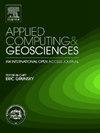使用预训练卷积神经网络的自动变异函数推理
IF 3.2
Q2 COMPUTER SCIENCE, INTERDISCIPLINARY APPLICATIONS
引用次数: 0
摘要
提出了一种利用卷积神经网络(cnn)从稀疏数据推断协方差函数的新方法。提出了两种工作流程:(1)直接预测变异函数模型参数;(2)在指定滞后距离下预测实验变异函数值,这两种工作流程平滑且易于自动拟合。工作流1的r平方为0.80,而工作流2的r平方更高,为0.96。通过旋转的数据增强提高了鲁棒性,并可用于检查变异函数的不确定性;可以得到各预测参数的分布,并将其用于不确定性建模。cnn是预先训练的,确保最小的计算时间和完全自动化的处理。工作流适用于稀疏或密集数据,但目前仅限于二维正态分数方差。本文章由计算机程序翻译,如有差异,请以英文原文为准。
Automatic variogram inference using pre-trained Convolutional Neural Networks
A novel approach is presented for inferring covariance functions from sparse data using Convolutional Neural Networks (CNNs). Two workflows are proposed: (1) direct prediction of variogram model parameters, and (2) prediction of experimental variogram values at specified lag distances, which are smooth and easily autofit. Workflow 1 achieves an r-squared of 0.80, while Workflow 2 attains a higher r-squared of 0.96. Data augmentation through rotation improves robustness, and can be used to examine variogram uncertainty; the distribution for each predicted parameter can be obtained and used in uncertainty modeling. The CNNs are pre-trained, ensuring minimal computational time and fully automated processing. The workflows are applicable to sparse or dense data but are currently limited to 2D normal score variograms.
求助全文
通过发布文献求助,成功后即可免费获取论文全文。
去求助
来源期刊

Applied Computing and Geosciences
Computer Science-General Computer Science
CiteScore
5.50
自引率
0.00%
发文量
23
审稿时长
5 weeks
 求助内容:
求助内容: 应助结果提醒方式:
应助结果提醒方式:


